Magura Gustav Pro Brakes
Stated Weight: 348 g per brake, w/o rotor or adapter
Blister’s Measured Weight:
- Gustav Pro, Front (cut hose with bar clamp and silver Performance pads, no rotors or adapters): 352 g
- Gustav Pro, Rear (cut hose with bar clamp and silver Performance pads, no rotors or adapters): 369 g
- Magura MDR-S Rotor (203 mm, no rotor bolts): 266 g
MSRP: $362 USD per brake (w/o rotor or adapter)
Bolted to: Kavenz VHP 16 & Transition Repeater EP8
Reviewer: 6’, 160 lb / 183 cm, 72.6 kg
Test Locations: Washington
Test Duration: 6 months

Intro
The Gustav M was Magura’s first hydraulic bike disc brake when it launched in 1996, and after a very long hiatus, they’re bringing back the Gustav name (drawn from that of their founder, Gustav Magura) and what they’ve come up with is pretty interesting.
Earlier iterations of the Gustav were known for being hugely powerful, at least by the standards of the day. The biggest, most gravity-oriented mountain bike brakes have gotten massively more powerful in recent years, so what has Magura done to compete in today’s market?
Design
It’s worth noting that Magura describes the new Gustav Pro as being suited for gravity MTB applications, but expressly mentions eMTBs and “SUV” bikes (i.e., cargo bikes) as intended use cases as well — and some of the design details seem clearly tailored to the latter options.
Gustav Pro Caliper
The design of the Gustav caliper is very clearly a Magura design. It’s a four-piston caliper with a forged one-piece design and uses a separate brake pad for each piston (i.e., four per caliper) instead of the usual two. The pads are kept in contact with the pistons by magnets rather than the more common leaf spring, and the hose fitting at the caliper uses a banjo bolt so that the hose orientation can be adjusted. As per usual for Magura, the Gustav Pro uses mineral oil for the brake fluid.
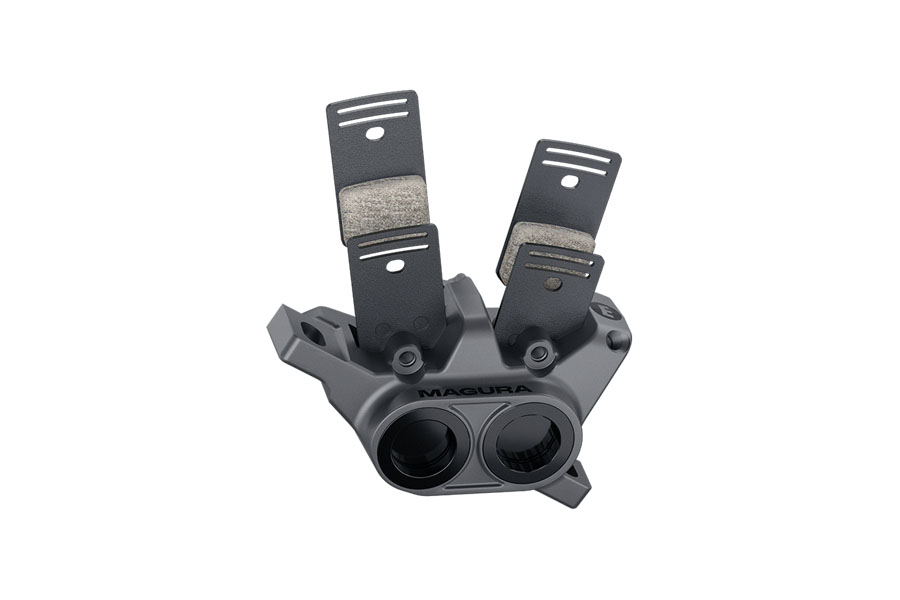
So far that’s all more or less the same as Magura’s longstanding flagship gravity brake, the MT7; the main thing that sets the Gustav caliper apart is that it’s a lot bigger. The Gustav Pro uses four 19mm-diameter pistons (up from 17 mm pistons on the MT7), and while 2 mm of diameter might not sound like that much, it adds up to 25% more total piston area.
The Gustav Pro also gets a new pad shape to go with the bigger caliper. Magura says the Gustav’s pads have 40% more material than the MT7 pads, for better durability and heat management; the Gustav Pro pads also feature cooling fins to help dissipate heat.
Another less visually obvious change is that the Gustav Pro is designed to use Magura’s new 2.5mm-thick MDR-S rotors — up from 2.0 mm on their other brakes. The bigger rotors come with a bit of a weight penalty, but Magura says that the added material improves heat dissipation and overall braking consistency so much that they purposefully don’t offer a 220 mm diameter version because they simply feel it isn’t needed. (For reference, Magura’s stated weights of 219 and 266 grams for the 180 and 203 mm MDR-S rotors, respectively, are about 40-50 grams heavier than the thinner MDR-C options.)
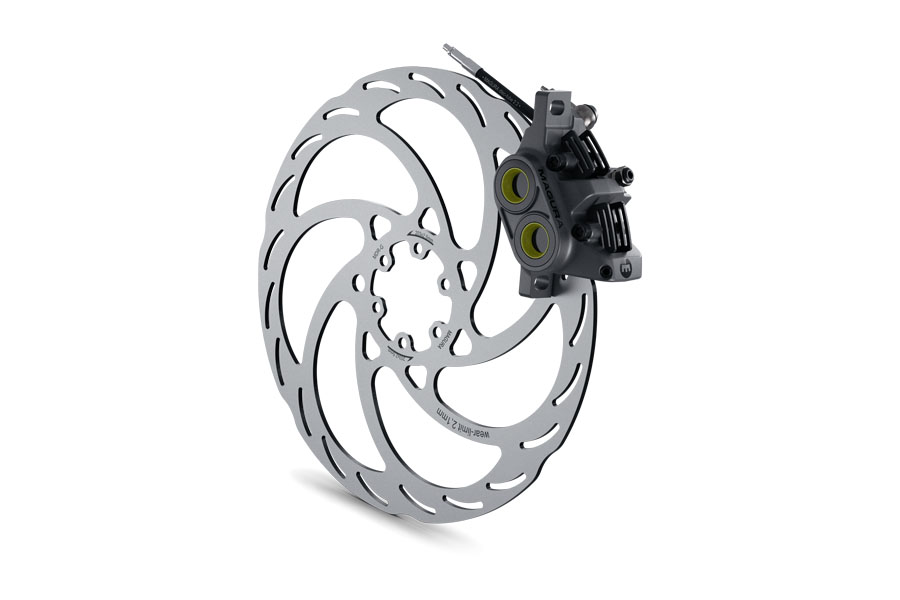
Magura says that 2.0mm-thick rotors are still compatible with the Gustav Pro if you prefer, or you just need to run a non-standard option in a pinch.
Gustav Pro Lever
The Gustav Pro lever design is very identifiably Magura, too, but relative to its caliper, the new lever design is much more visually different from that of the MT7. But let’s start with the commonalities: the Gustav Pro uses a radial master cylinder orientation and a carbon-reinforced plastic body. The lever blade is made from forged aluminum, and its shape is based on the Loic-Bruni-spec HC-W lever option for the MT7. Reach is adjustable tool-free, but there’s no contact-point adjustability to be found. The lever blade also features a designed-in breakaway point to help reduce the chance of damaging the main lever body assembly in a crash, and to hopefully leave you with enough lever blade left to get down the hill should you break off the tip.
Magura also says that their goal for the Gustav Pro was not so much to make a more powerful brake than the MT7, but one that’s more consistent in its performance under heavy use. To that end, the Gustav master cylinder has also been upsized to match the bigger caliper pistons (to 12 mm, from 10.5 mm on the MT7). That’s roughly a 30% increase in area, so the Gustav Pro actually has a slightly lower hydraulic leverage ratio than the MT7.
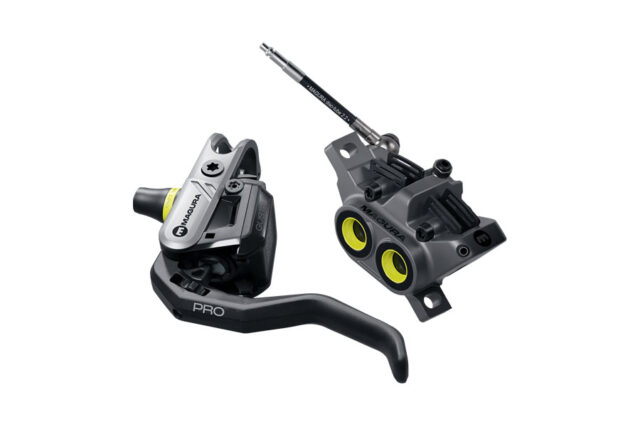
The idea here is twofold: (1) achieve a similar amount of power with less hydraulic pressure in the line, which Magura says improves consistency and mitigates sponginess in the lever if the brake isn’t bled perfectly, and (2) increase the overall oil volume, both for heat management reasons and to work better with Bosch’s ABS system for eBikes.
So far, we haven’t seen that system popping up on a lot of eMTBs, but Bosch does offer a “Trail” mode on their ABS system with off-road bikes in mind. So far, it seems to be getting more traction (sorry) on commuter and cargo bikes, but it’ll be interesting to see if that changes in the future.
Magura’s brake levers have long used self-tapping screws threaded directly into the composite lever body, but they’ve done away with those on the Gustav lever, which uses a hinged clamp with a single bolt. Shiftmix adapters for various styles of integrated controls are also available.
Easy Link
Magura has also revisited their hose connection design and came up with a new quick-release “Easy Link” system at the Gustav lever. In short, instead of using a typical threaded fitting with a one-time-use compression olive and barb, the Gustav Pro uses a push-in fitting that’s secured by a wire clip inside the lever assembly. The lowest-profile version of the fitting is crimped onto the line; Magura sells the crimping tool in both mechanical and electronic versions for shops or bike companies that are assembling hoses in large volumes, but the tools are on the expensive side for everyday home mechanics.
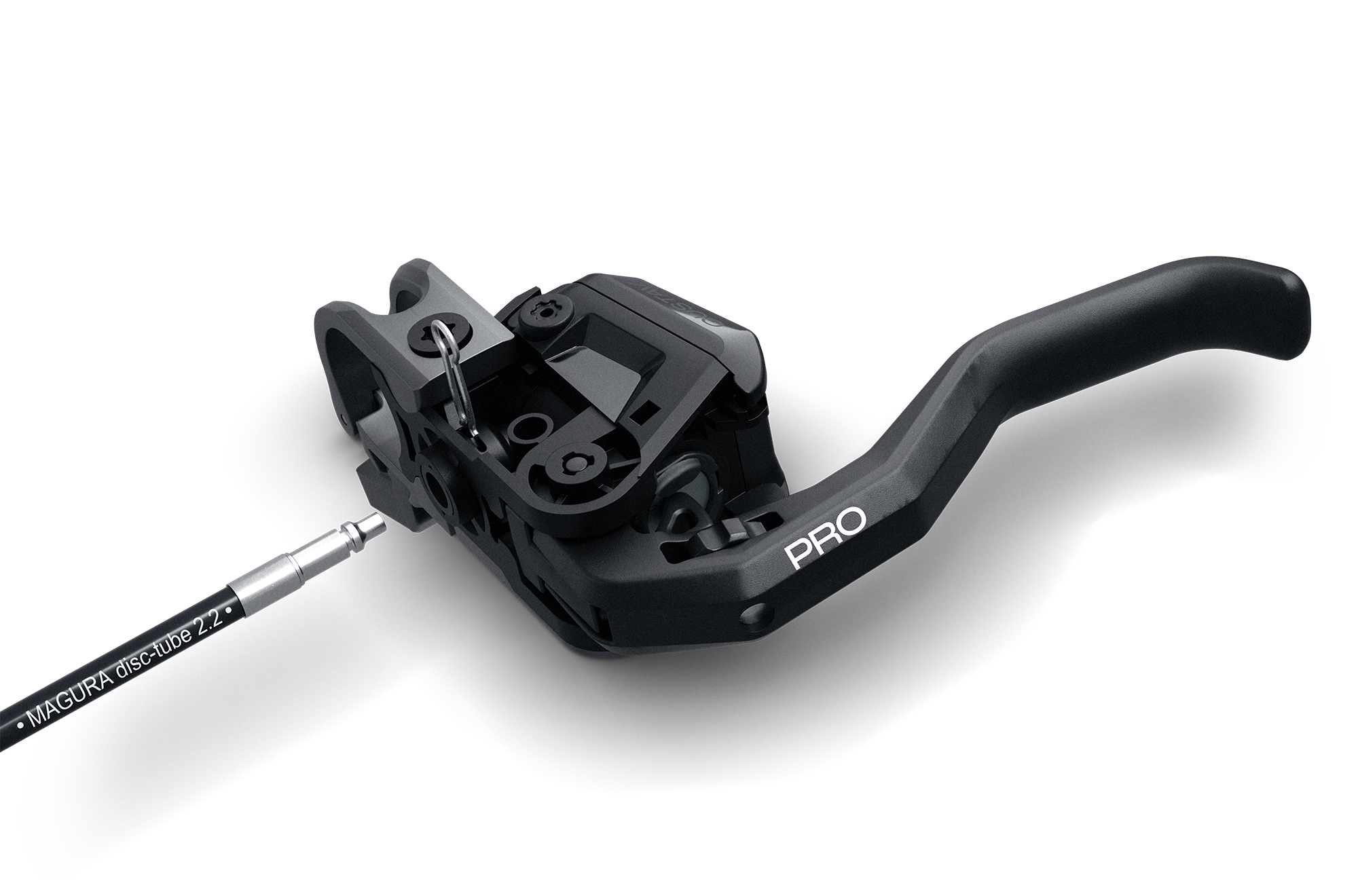
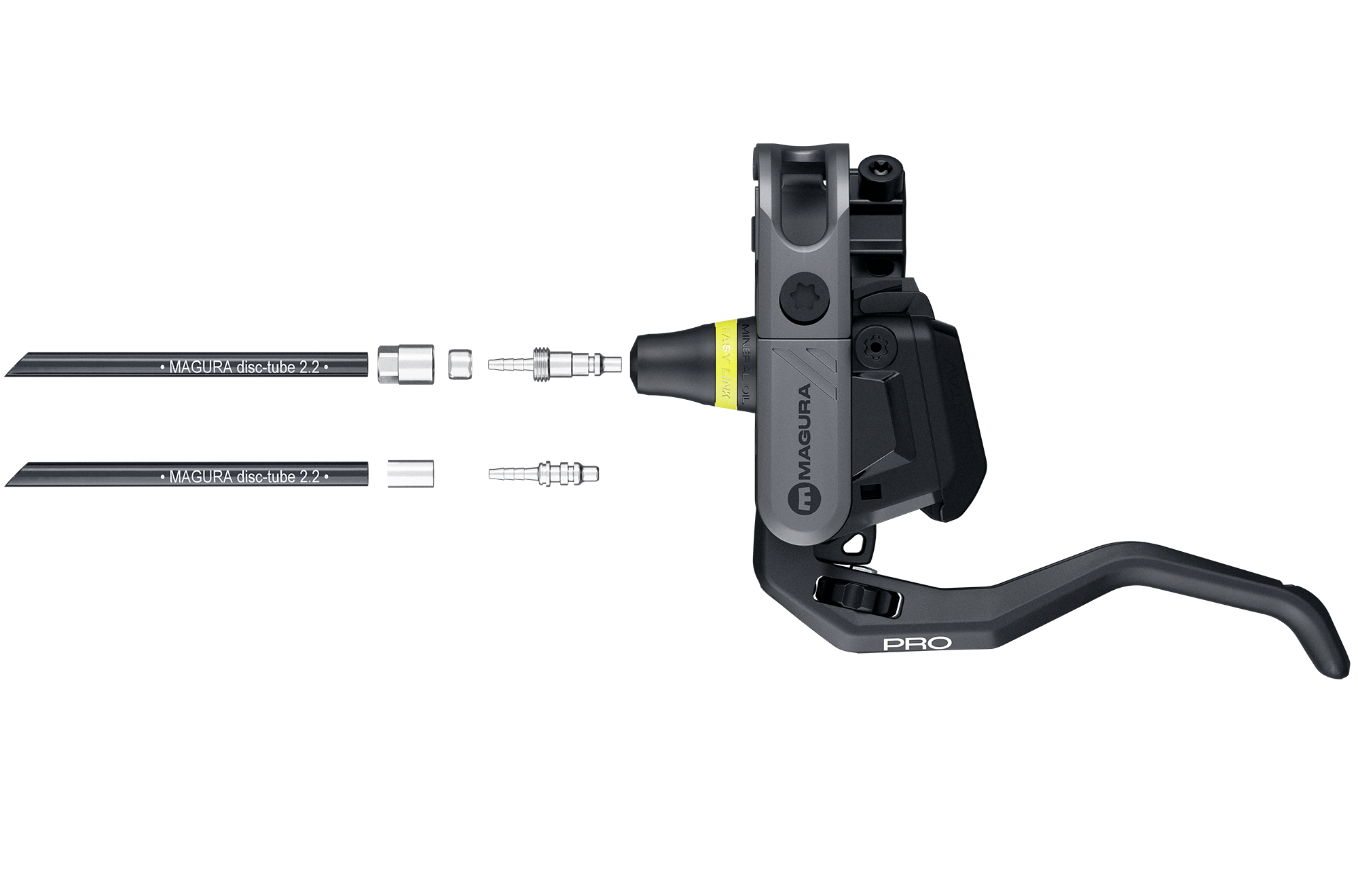
Magura says that the Easy Link arrangement has a few benefits. First, it’s simply quicker and easier to attach and disconnect the hose from the lever end, and you don’t need to replace the fittings when you do so. That potentially saves time when swapping brakes or assembling bikes, but the bigger advantage for the average consumer is that the crimped-on version of the fitting is small enough to fit through internal routing ports on most frames — including those going through the headset.
That has the potential to make dealing with headset cable routing (or regular internal routing) a lot easier. If you need to take things apart, you can simply unclip the brake hose and, at least in theory, re-route it without needing any replacement fittings or having to re-bleed the brake afterward. The grumpy old man in me still sees that as a solution for a problem that never should have existed in the first place, but it’s not Magura’s fault that headset routing is a thing now, and it’s nice that they’re doing what they can to make the Gustavs easier to live with.
FULL REVIEW
The Gustav Pro brakes look huge, but does their performance make the same big impression? Read on to find out what we think after six months of testing the Gustav Pro brakes.

Installation & Setup
While most modern disc brakes are broadly similar in their setup procedures, the Gustav Pro is different enough that it’s worth digging into the installation details.
The Gustav Pro shows up out of the box with some rather lengthy hoses, with the levers and calipers disconnected from one another. The hoses are equipped with a crimped-on fitting designed for Magura’s new Easy Link attachment system. In place of the disposable olive and barb used with most other brake designs, the Easy Link fitting is designed to be both easily installed and removed via a push-in system that retains the hose in the lever via a small wire clip.
There are two types of hose fittings for the Gustav Pros: a crimp-on version designed for efficient installation at OEMs and shops, and a thread-on version designed for home mechanics. Both versions still require pressing a barb into the hose, but the crimp-on one uses a sleeve around the hose that is secured with a specialty crimping tool. The thread-on version uses a 5 mm wrench to secure a threaded sleeve that wraps around the hose and secures the barb in place. Once installed on the hose, the fitting is simply pushed into the lever body, where a wire clip snaps around the fitting and holds it securely in place. The wire clip needs to have no more than a 4 mm gap between the ends to make sure that it’s fully locked into place.

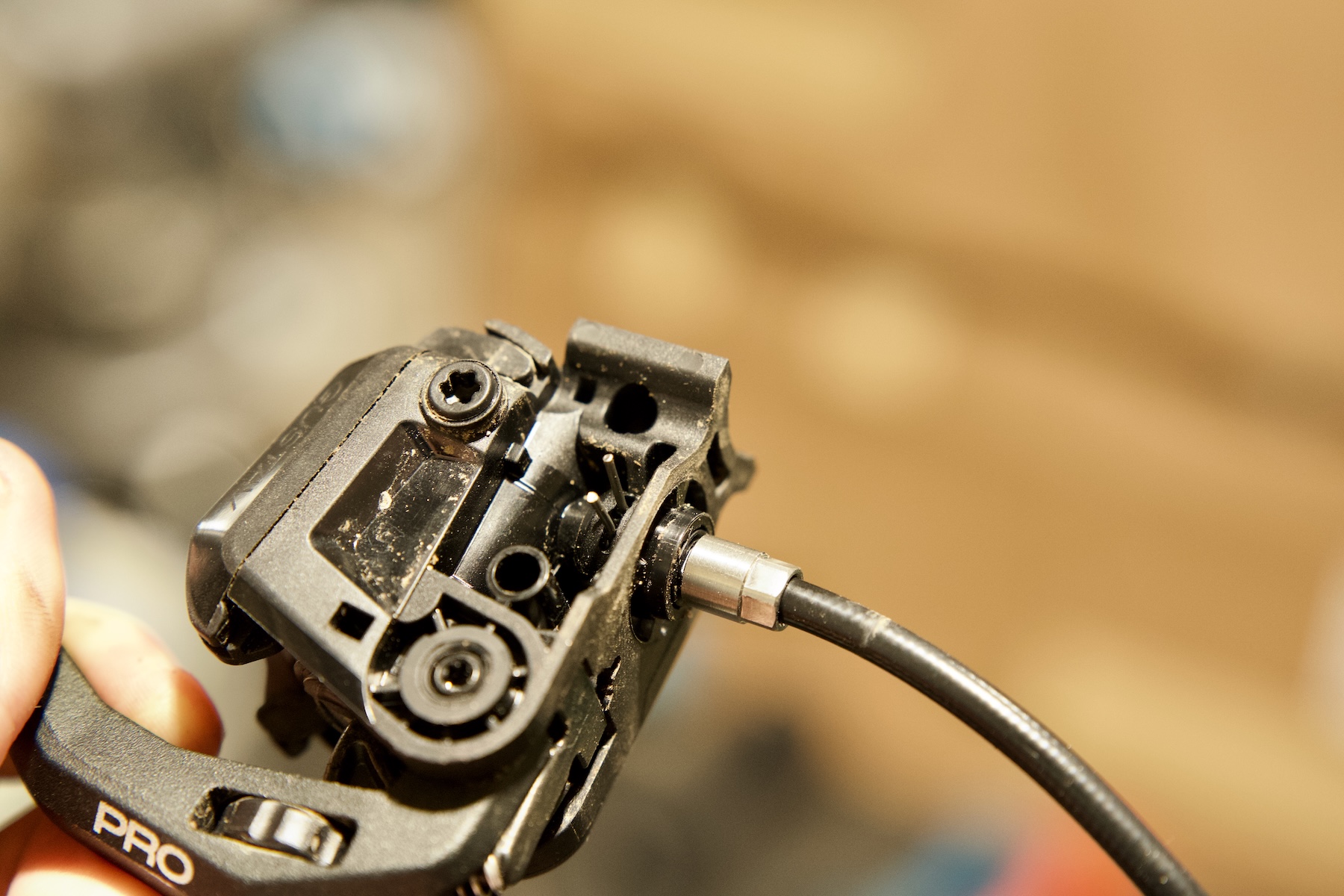
Though it won’t make sense for most home mechanics to buy the crimping tool, the crimped arrangement is especially slick and time-saving. It also produces a very slim hose fitting that can fit through most internal routing ports (even headsets), allowing for easy brake removal without needing to cut the hose. The thread-on version is bulkier and can’t slide through guided housing ports on most frames, though both versions still have the benefit of allowing the hose to be easily disconnected and reconnected at the lever without requiring a new olive and barb.
In practice, this meant that installation was remarkably straightforward. Install the fitting, push the hose into the lever, pull the lever to break the internal membrane sealing the lever, and all that’s left to do is a quick lever bleed. Somewhat strangely, despite the levers being a flip-flop design so that they can be run on either the right or left, only one side of the lever has a bleed port. To bleed the left-hand lever, you’ll need to flip it around on the bar to orient the bleed port up.
While we’re on the topic of setup, I’ll quickly note that the truly massive reservoir of the Gustav Pro means that the use of Magura’s ShiftMix adapters is basically a requirement rather than an option. Paired with the very long stock lever blade, I found locating both dropper levers and shifters to be a challenge, with standalone clamp versions needing to be unusably far in either inboard or outboard directions to not interfere with the bulbous lever body. The ShiftMix adapters are effective, but the Shimano I-Spec one that I used had some strange ergonomics in how far it drops the shifter below the handlebar. I vastly prefer being able to use separate brake and shifter/dropper lever clamps, but unfortunately, I can’t see that being an option here for most people.
While Magura may be offering aftermarket lever options down the line, the stock lever blade on the Gustav Pro is very long, and also can’t be adjusted to be all that close to the bar. Apparently, this is related to design limitations around making the Gustav Pro compatible with Bosch’s ABS system, but in any case, folks with smaller hands may struggle with the stock lever adjustment range. The shape is very similar to the Loic Bruni-designed HC-W lever from the Magura MT7 brake, which also favors larger hands. I ended up running the reach adjustment as close to the bars as possible, and it was still a good bit farther out than I prefer.

As a final point, folks who have used the Magura MT7 may be familiar with how difficult it is to get them running rub-free. While the Gustav Pro seems to be a little easier to set up in that regard, it’s still a bit fiddly, and we had to spend some extra time straightening rotors to get the brakes running interference-free.
On-Trail Performance
When I published my Flash Review of the Gustav Pro, I had found them to be impressively consistent and excellent in the heat management department, but perhaps a bit lacking in bite and all-out power as compared to some other burly, gravity-focused brakes. While that has largely held true, there have been a few changes along the way that have given me a better sense of the Gustav Pro’s potential.
At first squeeze, the familiar short free stroke of the popular Magura MT7 is present here with the Gustav Pro. The Gustav Pro lever blade feels nearly identical to the Loic Bruni-designed HC-W lever in its shape, and like the HC-W, there’s no bite point adjustment. The Gustav Pro’s bite point feels a bit softer than the MT7, but it’s still relatively solid compared to a lot of other big gravity brakes. The lever feel isn’t the lightest — roughly on-par with the MT7 — but the actual lever bodies feel a bit stiffer than the MT7. Though it’s still largely made of reinforced plastic parts, the Gustav Pro lever body feels like it doesn’t flex quite as much as the MT-series lever does under heavy braking.

The massive Gustav Pro caliper might suggest the same brutal power of the also-giant SRAM Maven, but the two are quite different in their power delivery. In practice, the Gustav Pro’s power delivery is quite gentle, with a fairly soft initial power profile. Pulling on the long lever blade sees braking power come on steadily and smoothly, in a much more linear fashion than the quick-to-build power profile of the SRAM Maven. Even compared to some less powerful brakes than the Maven, like the Formula Cura 4, Hayes Dominion A4, and even the Magura MT7, the Gustav Pro’s relatively mellow initial bite took some getting used to.
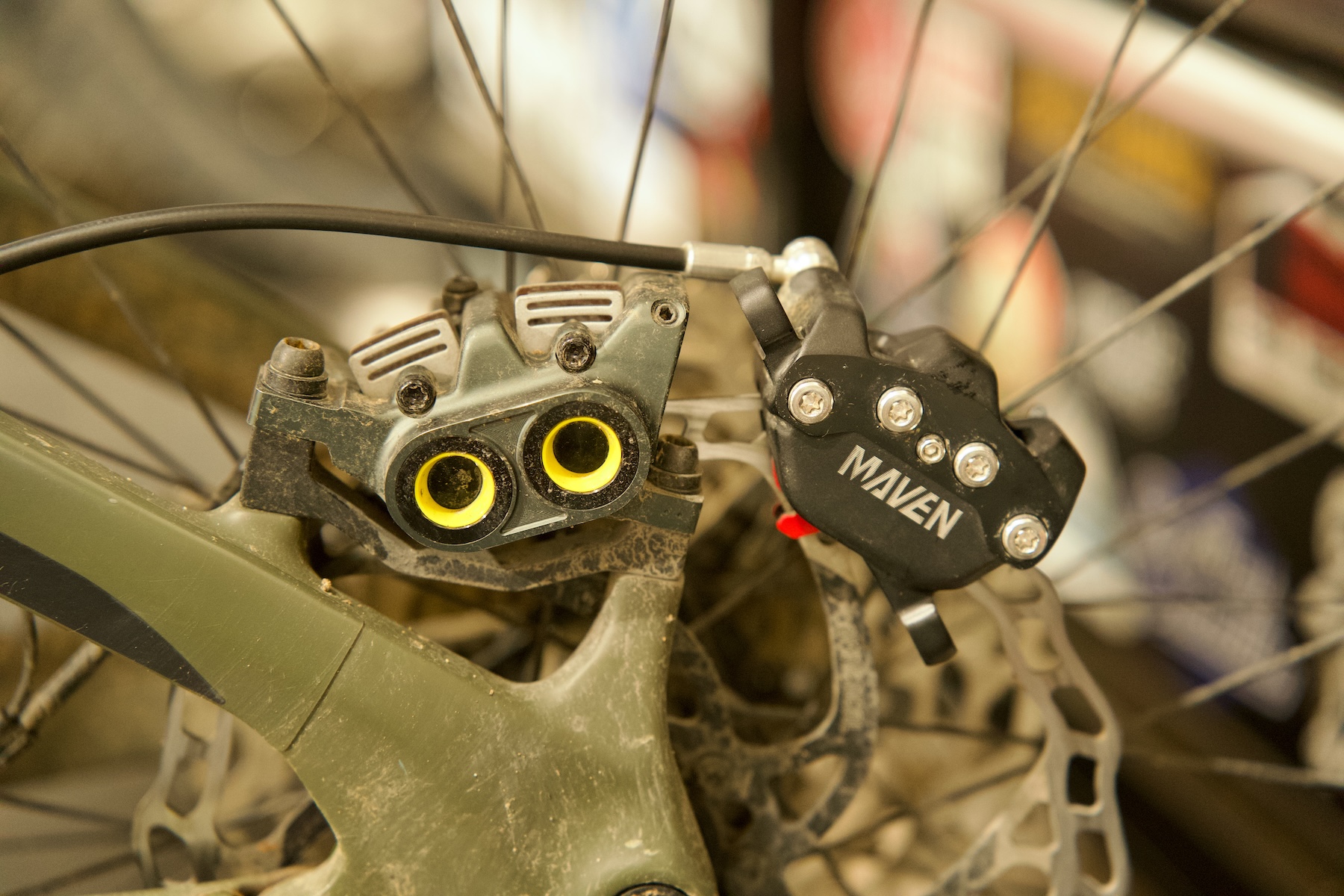
Pulling deeper into the power band, the Gustav Pro builds power gradually and predictably, with lots of modulation on tap. On one hand, the relatively mellow initial bite makes the Gustav Pro easy to manage in slippery conditions. In trade, the Gustav Pro’s power doesn’t arrive with much urgency, requiring more deliberate tugs at the lever to slow things down rather than the quick, light stabs at the lever that other brakes allow. At least in the stock configuration, the Gustav Pros didn’t deliver the power I expected.
Fortunately, I found some improvement in a pad upgrade. Our set of Gustav Pros came stock with Magura’s Sport pads, which offer a long lifespan but aren’t as aggressive in their bite as I would like. Magura later sent their new silver Performance pads, which compromise a bit on lifespan to deliver a sharper bite and more peak power. While it wasn’t a night-and-day difference, the upgraded pads brought the Gustav Pro closer to what I expect out of a higher-end gravity brake. The biggest gains were in initial bite, with the silver Performance pads delivering more power earlier in the stroke. Even considering the difference in power delivery, I still felt like the Gustav Pro only matched the power of the MT7, not delivering the stopping authority that I expected from such a big brake.

Where the Gustav Pro leads is in consistency. The huge fluid volume, large caliper, and optional super-thick 2.5 mm MDR-S rotors all imply good heat management, and the Gustav Pro really delivers. I might even go so far as to say that the Gustav Pro is the most consistent brake I’ve ever tested in how it retains its power and lever feel on even the most brutally long descents.
I tested the Gustav Pro on both my Kavenz VHP 16 and my Transition Repeater EP8. In my experience, the brakes really came into their own on the heavy (~53 lb) Repeater, where their heat management abilities really stood out. Where other brakes can start to howl and lose power while managing such a heavy bike during long descents, the Gustav Pro stays relentlessly consistent, with no discernable changes in lever feel. It’s remarkable in that regard, and probably the most consistent brake I’ve tried.

All things considered, the Gustav Pro isn’t a brake I’d likely choose to run other than on a heavy eMTB that’ll be seeing sustained descents where heat becomes an issue, though. As dead-consistent as the Gustav Pros are, I think other brakes on the market manage to get pretty close while delivering more power and a more direct lever feel. I could see heavy riders who struggle with heat resistance feeling differently than I do, and folks particularly averse to maintenance will like the mega-thick pads and ability to hold a bleed (more on that below). For my preferences, though, the SRAM Maven, Hayes Dominion A4, and others offer more bite, peak power, and ultimately, performance.
Rotor Sizes & Brake Pads
I tested the Gustav Pro with Magura’s 2.5 mm thick MDR-S rotors as well as with some more standard 2.0 mm thick Galfer rotors. Those chunky MDR-S rotors are unsurprisingly quite heavy at 266 g each, but all that extra mass plays into the stellar heat management of the Gustav Pro. While heavier riders who struggle with overheating may opt to stick with the MDR-S rotors, I ended up preferring other rotors for a couple of reasons.
First was the ability to run a 223 mm rotor for more power. The MDR-S rotors max out at 203 mm, and given the power profile of the Gustav Pro, I found a bigger 223 mm front rotor to be an asset for the steep trails near me, while the mass of the caliper still kept performance consistent. The next reason, at least on my Kavenz VHP 16, was that the MDR-S rotors are so massive that they take quite a bit of time to get to operating temperature. It’s not an issue I’ve run into before with 2.0 mm rotors. The MDR-S rotors were much better suited to my chunky Transition Repeater EP8, whose weight helped get things warmed up much more quickly than the lighter, motor-free Kavenz, but I still ultimately preferred to run a larger 223 mm rotor up front.

I already talked a good bit about the stock Sport pads and upgraded silver Performance ones, but if I were buying the Gustav Pro, I’d immediately make that pad switch. The Gustav Pro is marketed towards cargo bikes, too, and I could see the Sport pads being the right choice for that use case, but I would be great to see Magura including the more aggressive pads as a stock option for mountain bike use. The only downside of the Performance pads is that they seem to wear a bit faster, but given the much thicker-than-standard pads used by the Gustav Pro, they should still last quite a long time.
The Gustav Pro caliper uses different, thicker pads than the MT7, but the layout is the same, with four pads per caliper (one per piston). Unfortunately, like the MT7, the Gustav Pro also suffers from pad rattle as the magnetically retained pads shift slightly during riding. The Gustav Pro pads have larger backing plates than the MT7 ones, thanks to the extended cooling fins on the backplate, and that seems to make the rattle even worse. Magura’s brakes are far from the only ones to rattle slightly, but the Gustav Pros are one of the noisier examples in that respect.

Maintenance & Durability
One of Magura’s big goals with the Gustav Pro was to create a very consistent, low-maintenance brake, and I think they’ve succeeded in that. Throughout testing, the Gustav Pros didn’t need a single bleed outside of when I swapped them between bikes. The bite point was among the most consistent I’ve experienced in all manner of riding conditions, and the extra-thick brake pads should mean that pad replacements are less frequent, too. I’ve grown used to dealing with sticky pistons, stubborn bubbles, wandering bite points, and other issues over the years, but the Gustav Pros were blissfully maintenance-free.
When it comes time to bleed the Gustav Pro, the bleed procedure is nearly identical to the MT7. One welcome change is the interference-fit bleed port at the caliper side, which allows for a cleaner bleed by allowing the bleed fitting to be set into place before opening the bleed port. One slight annoyance is that the left-hand lever needs to be flipped upside down to access the bleed port. This was a very minor issue, and given that the Gustav Pros didn’t require a re-bleed during testing, it proved irrelevant after initial install.

The Gustav Pro levers also feel stiffer than the MT-series levers used on the MT7, though I still can’t fully shake my skepticism of Magura’s Carbotecture lever bodies, largely due to having seen multiple broken levers from their MT series, which uses the same material. That said, Magura’s breakaway lever blade seems to do an effective job of protecting the rest of the lever body in a crash.
I had a modest spill towards the end of testing and managed to snap the lever blade at the designed failure point (there’s a notch in the lever to encourage it to break rather than transfer force into the lever body). It meant that I needed to source a new lever blade despite a not-that-bad crash, but it also meant that the lever body escaped unscathed. That gave me some confidence in the resilience of the lever bodies, but I’ll still be careful to inspect the levers after a crash.
Bottom Line
On one hand, the Gustav Pro proved to be a true set-and-forget brake, delivering a remarkably consistent lever feel and smooth modulation while requiring no maintenance through six months of use. On the other hand, it doesn’t quite meet my expectations for power from a gravity-focused brake, while also having some shortcomings in its limited lever adjustment and fitment issues with other controls, thanks to its large footprint on the bars.
While riders looking for a true set-and-forget brake with maximal heat resistance will find the Gustav Pro to be a dependable partner, its power profile makes it hard to recommend for more aggressive riders relative to other options in the Gravity category.

These look sturdy. Needing a special crimping tool will limit aftermarket sales (if Magura cares). The olive/barb system may be a bit fiddly, but I can do it in my garage with 100% reliability.
You don’t *need* the crimp tool to install them — as mentioned in the first look, there’s a threaded version of the fitting that works like a standard barb and olive; it’s just bigger diameter and won’t fit through most guided internal routing like the crimped one will. The banjo fitting at the caliper end is also threaded, so you can shorten the line from that end and preserve the factory crimped fitting, too — you’ll just probably need to bleed the line in that case.
Thanks. Good to know there is a workaround for the home mechanic without unlimited tool budget!
Why would you write a review without actually having your hands on the product? No value added article….
This isn’t a review. It’s a first look, published on the day that Magura announced the Gustav, describing its design and other details. Hence “stay tuned for a Full Review down the line.”
We do have a set in for review, and will publish one once we’re ready to do it justice.